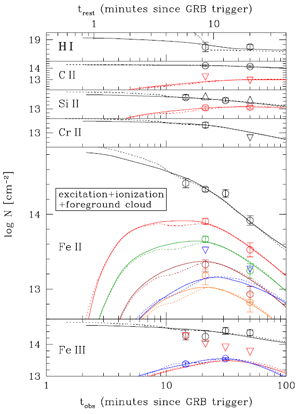- Details
- Published on 05 December 2012
Vol. 549
In section 2. Astrophysical processes
Time-dependent excitation and ionization modelling of absorption-line variability due to GRB 080310
 Fluorescent pumping is known in many dense astrophysical sources,
but the variations usually vary over many years. In this gamma-ray
burst (GRB), the timescale was tens of minutes. The present study uses
new analytical and numerical tools to model the time-dependent
spectrum formation of a GRB afterglow induced in the
circumburst medium. The photo-excitation effects of the
GRB have been shown in other papers in this series by the same
authors, based on spectral line variations, but this paper
demonstrates - using panchromatic modeling of the broadband spectral
energy distribution - that an additional mechanism is required. The
authors find that the large abundance of Fe+2 requires
photo-ionization of Fe+. For this purpose, the authors also
present new computations of the photo-ionization cross section from the
Fe II ground state to excited levels of Fe III using different atomic
structure codes. The results are also relevant for the study of broad
absorption line quasars and luminous blue variables, among other
sources. The authors also conclude that correct modeling of the energy
distribution and the time dependence of the lines requires an iron
abundance above solar and a low neutral hydrogen column density. The
combination of line- and continuum time-dependent modeling is a major
step in the analysis of sightlines toward GRBs.
Fluorescent pumping is known in many dense astrophysical sources,
but the variations usually vary over many years. In this gamma-ray
burst (GRB), the timescale was tens of minutes. The present study uses
new analytical and numerical tools to model the time-dependent
spectrum formation of a GRB afterglow induced in the
circumburst medium. The photo-excitation effects of the
GRB have been shown in other papers in this series by the same
authors, based on spectral line variations, but this paper
demonstrates - using panchromatic modeling of the broadband spectral
energy distribution - that an additional mechanism is required. The
authors find that the large abundance of Fe+2 requires
photo-ionization of Fe+. For this purpose, the authors also
present new computations of the photo-ionization cross section from the
Fe II ground state to excited levels of Fe III using different atomic
structure codes. The results are also relevant for the study of broad
absorption line quasars and luminous blue variables, among other
sources. The authors also conclude that correct modeling of the energy
distribution and the time dependence of the lines requires an iron
abundance above solar and a low neutral hydrogen column density. The
combination of line- and continuum time-dependent modeling is a major
step in the analysis of sightlines toward GRBs.


